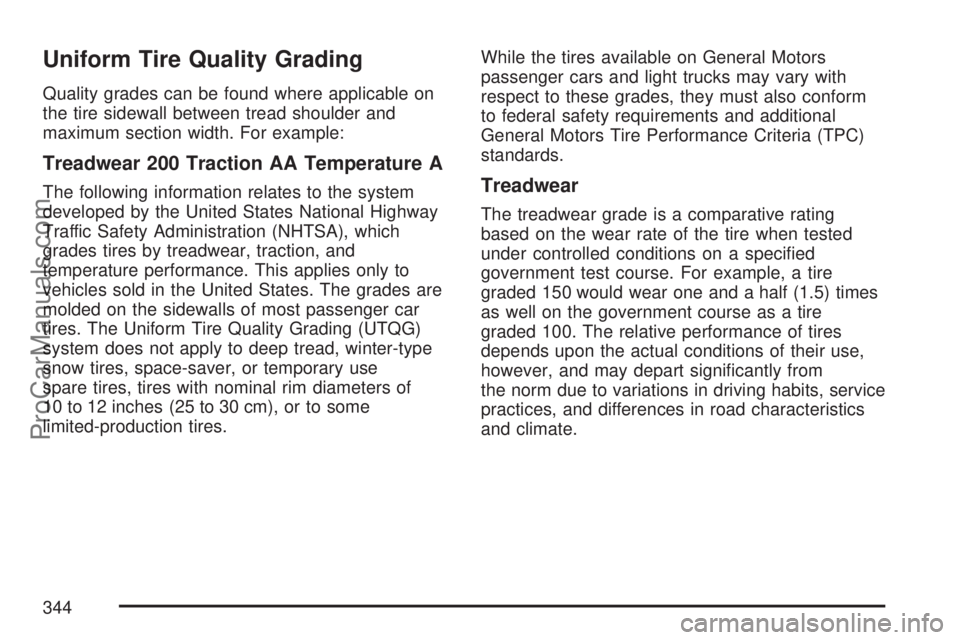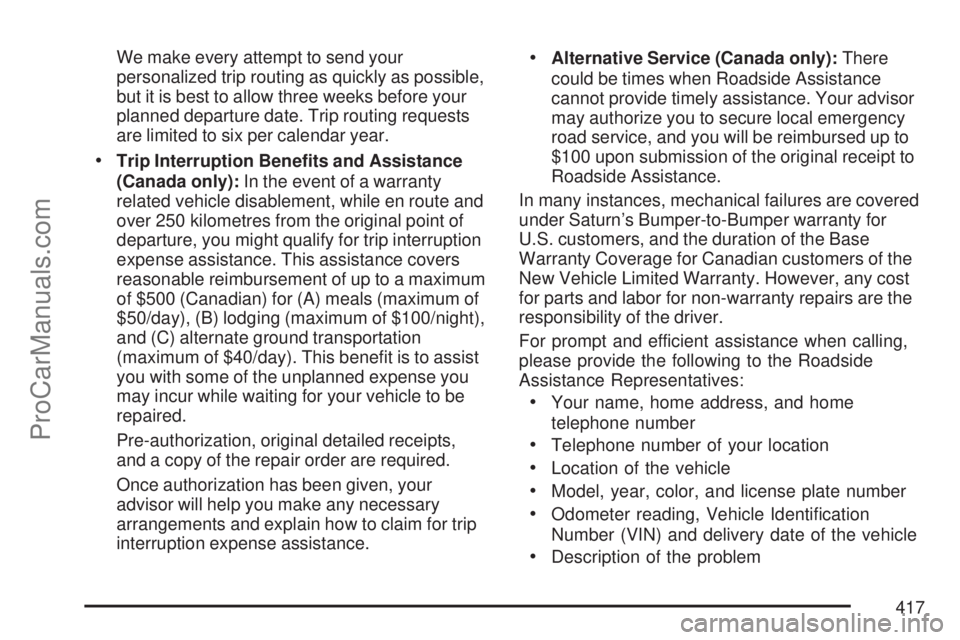ESP SATURN ION 2007 Owner's Manual
[x] Cancel search | Manufacturer: SATURN, Model Year: 2007, Model line: ION, Model: SATURN ION 2007Pages: 440, PDF Size: 2.93 MB
Page 344 of 440

Uniform Tire Quality Grading
Quality grades can be found where applicable on
the tire sidewall between tread shoulder and
maximum section width. For example:
Treadwear 200 Traction AA Temperature A
The following information relates to the system
developed by the United States National Highway
Traffic Safety Administration (NHTSA), which
grades tires by treadwear, traction, and
temperature performance. This applies only to
vehicles sold in the United States. The grades are
molded on the sidewalls of most passenger car
tires. The Uniform Tire Quality Grading (UTQG)
system does not apply to deep tread, winter-type
snow tires, space-saver, or temporary use
spare tires, tires with nominal rim diameters of
10 to 12 inches (25 to 30 cm), or to some
limited-production tires.While the tires available on General Motors
passenger cars and light trucks may vary with
respect to these grades, they must also conform
to federal safety requirements and additional
General Motors Tire Performance Criteria (TPC)
standards.Treadwear
The treadwear grade is a comparative rating
based on the wear rate of the tire when tested
under controlled conditions on a speci�ed
government test course. For example, a tire
graded 150 would wear one and a half (1.5) times
as well on the government course as a tire
graded 100. The relative performance of tires
depends upon the actual conditions of their use,
however, and may depart signi�cantly from
the norm due to variations in driving habits, service
practices, and differences in road characteristics
and climate.
344
ProCarManuals.com
Page 345 of 440

Traction – AA, A, B, C
The traction grades, from highest to lowest, are
AA, A, B, and C. Those grades represent the tire’s
ability to stop on wet pavement as measured
under controlled conditions on speci�ed
government test surfaces of asphalt and concrete.
A tire marked C may have poor traction
performance.
Warning:The traction grade assigned to this tire
is based on straight-ahead braking traction
tests, and does not include acceleration, cornering,
hydroplaning, or peak traction characteristics.
Temperature – A, B, C
The temperature grades are A (the highest), B,
and C, representing the tire’s resistance to
the generation of heat and its ability to dissipate
heat when tested under controlled conditions on a
speci�ed indoor laboratory test wheel. Sustained
high temperature can cause the material of the tire
to degenerate and reduce tire life, and excessive
temperature can lead to sudden tire failure.
The grade C corresponds to a level of performance
which all passenger car tires must meet under
the Federal Motor Vehicle Safety Standard
No. 109. Grades B and A represent higher levels
of performance on the laboratory test wheel
than the minimum required by law.
Warning:The temperature grade for this tire is
established for a tire that is properly in�ated
and not overloaded. Excessive speed,
underin�ation, or excessive loading, either
separately or in combination, can cause heat
buildup and possible tire failure.
345
ProCarManuals.com
Page 349 of 440

If a Tire Goes Flat
It is unusual for a tire to blowout while you are
driving, especially if you maintain your vehicle’s
tires properly. If air goes out of a tire, it is
much more likely to leak out slowly. But if you
should ever have a blowout, here are a few tips
about what to expect and what to do:
If a front tire fails, the �at tire will create a drag
that pulls the vehicle toward that side. Take your
foot off the accelerator pedal and grip the
steering wheel �rmly. Steer to maintain lane
position, and then gently brake to a stop well out
of the traffic lane.
A rear blowout, particularly on a curve, acts much
like a skid and may require the same correction
you would use in a skid. In any rear blowout
remove your foot from the accelerator pedal.
Get the vehicle under control by steering the way
you want the vehicle to go. It may be very
bumpy and noisy, but you can still steer. Gently
brake to a stop, well off the road if possible.{CAUTION:
Lifting a vehicle and getting under it to do
maintenance or repairs is dangerous
without the appropriate safety equipment
and training. The jack provided with your
vehicle is designed only for changing a
�at tire. If it is used for anything else, you
or others could be badly injured or killed
if the vehicle slips off the jack. Use the
jack provided with your vehicle only for
changing a �at tire.
If a tire goes �at, the next part shows how to use the
jacking equipment to change a �at tire safely.
349
ProCarManuals.com
Page 416 of 440

Who is Covered?
Roadside Assistance coverage is for the vehicle
operator, regardless of ownership. In Canada,
a person driving this vehicle without the consent of
the owner is not eligible for coverage.
The following services are provided in the U.S.
during the Bumper-to-Bumper warranty period and
in Canada, during the Base Warranty coverage
period of the New Vehicle Limited Warranty, up to
a maximum coverage of $100.
Fuel Delivery:Delivery of enough fuel for the
vehicle to get to the nearest service station
(approximately $5 Canada). Service to provide
diesel may be restricted. For safety reasons,
propane and other alternative fuels are
not provided through this service.
Lock-out Service:To ensure security, the
driver must present personal identi�cation
before lock-out service is provided. In Canada,
the vehicle registration is also required.
Lock-out service is covered at no charge if
you are unable to gain entry into your vehicle.
A remote unlock may be available if you
have an active OnStar
®subscription.
Emergency Tow From a Public Roadway or
Highway:Tow to the nearest Saturn retailer
for warranty service or in the event of a
vehicle-disabling accident. Winch-out
assistance provided when the vehicle is mired
in sand, mud, or snow.
Flat Tire Change:Installation of a spare tire
in good condition, when equipped and
properly in�ated is covered at no charge.
The customer is responsible for the repair or
replacement of the tire if not covered by a
warrantable failure.
Jump Start:No-start occurrences which
require a battery jump start are covered at no
charge.
Trip Routing Service (Canada only):Upon
request, Roadside Assistance will send you
detailed, computer personalized maps,
highlighting your choice of either the most
direct route or the most scenic route to your
destination, anywhere in North America, along
with helpful travel information pertaining to
your trip.
416
ProCarManuals.com
Page 417 of 440

We make every attempt to send your
personalized trip routing as quickly as possible,
but it is best to allow three weeks before your
planned departure date. Trip routing requests
are limited to six per calendar year.
Trip Interruption Bene�ts and Assistance
(Canada only):In the event of a warranty
related vehicle disablement, while en route and
over 250 kilometres from the original point of
departure, you might qualify for trip interruption
expense assistance. This assistance covers
reasonable reimbursement of up to a maximum
of $500 (Canadian) for (A) meals (maximum of
$50/day), (B) lodging (maximum of $100/night),
and (C) alternate ground transportation
(maximum of $40/day). This bene�t is to assist
you with some of the unplanned expense you
may incur while waiting for your vehicle to be
repaired.
Pre-authorization, original detailed receipts,
and a copy of the repair order are required.
Once authorization has been given, your
advisor will help you make any necessary
arrangements and explain how to claim for trip
interruption expense assistance.
Alternative Service (Canada only):There
could be times when Roadside Assistance
cannot provide timely assistance. Your advisor
may authorize you to secure local emergency
road service, and you will be reimbursed up to
$100 upon submission of the original receipt to
Roadside Assistance.
In many instances, mechanical failures are covered
under Saturn’s Bumper-to-Bumper warranty for
U.S. customers, and the duration of the Base
Warranty Coverage for Canadian customers of the
New Vehicle Limited Warranty. However, any cost
for parts and labor for non-warranty repairs are the
responsibility of the driver.
For prompt and efficient assistance when calling,
please provide the following to the Roadside
Assistance Representatives:
Your name, home address, and home
telephone number
Telephone number of your location
Location of the vehicle
Model, year, color, and license plate number
Odometer reading, Vehicle Identi�cation
Number (VIN) and delivery date of the vehicle
Description of the problem
417
ProCarManuals.com
Page 419 of 440

vehicle speed, safety belt usage, airbag
readiness, airbag performance, and the
severity of a collision. This information has
been used to improve vehicle crash
performance and may be used to improve
crash performance of future vehicles and
driving safety. Unlike the data recorders on
many airplanes, these on-board systems do not
record sounds, such as conversation of
vehicle occupants.
To read this information, special equipment is
needed and access to the vehicle or the
device that stores the data is required. GM will
not access information about a crash event
or share it with others other than:
with the consent of the vehicle owner or, if
the vehicle is leased, with the consent of
the lessee,
in response to an official request of police
or similar government office,
as part of GM’s defense of litigation
through the discovery process, or
as required by law.In addition, once GM collects or receives data,
GM may:
use the data for GM research needs,
make it available for research where
appropriate con�dentiality is to be
maintained and need is shown, or
share summary data which is not tied to a
speci�c vehicle with non-GM organizations
for research purposes.
Others, such as law enforcement, may have
access to the special equipment that can read
the information if they have access to the
vehicle or the device that stores the data.
If your vehicle has OnStar
®, please check the
OnStar®subscription service agreement or
owner manual for information on its operations
and data collection.
419
ProCarManuals.com
Page 422 of 440

If your vehicle cannot be driven, know where
the towing service is taking it. Get a card
from the tow truck operator or write down the
driver’s name, the service’s name, and the
phone number.
Remove any valuables from your vehicle
before it is towed away. Make sure this
includes your insurance information and
registration if you keep these items in your
vehicle.
Gather the important information you need
from the other driver. Things like name,
address, phone number, driver’s license
number, vehicle license plate, vehicle make,
model and model year, Vehicle Identi�cation
Number (VIN), insurance company and
policy number, and a general description of
the damage to the other vehicle.
If possible, call your insurance company from
the scene of the accident. They will walk you
through the information they need. If they
ask for a police report, phone or go to
the police department headquarters the next
day and you can get a copy of the report for a
nominal fee. In some states/provinces with
“no fault” insurance laws, a report may not be
necessary. This is especially true if there
are no injuries and both vehicles are driveable.
Choose a reputable collision repair facility
for your vehicle. Whether you select a
Saturn retailer or a private collision repair
facility to �x the damage, make sure you are
comfortable with them. Remember, you
will have to feel comfortable with their work for
a long time.
Once you have an estimate, read it carefully
and make sure you understand what work
will be performed on your vehicle. If you have
a question, ask for an explanation. Reputable
shops welcome this opportunity.
422
ProCarManuals.com